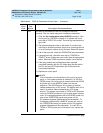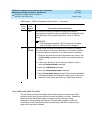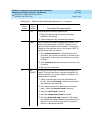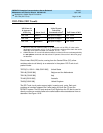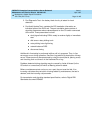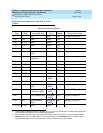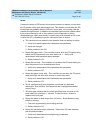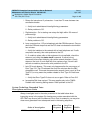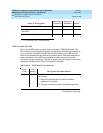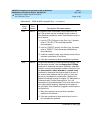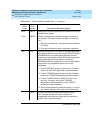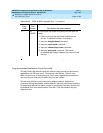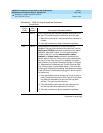
DEFINITY Enterprise Communications Server Release 5
Maintenance and Test for R5vs/si
555-230-123
Issue 1
April 1997
Maintenance Object Repair Procedures
Page 10-447DID-TRK (DID Trunk)
10
Notes:
A common trouble on DID trunks, which reports no errors or alarms, occurs when
the CO busies out the port (disconnects port). This situation occurs when the CO
thinks there are problems with the DID port. In this case, no incoming calls are
possible through this port. In addition to complaints received from outside callers
trying unsuccessfully to call in, this problem can be diagnosed by listing
measurements on lightly used trunks. If a particular port is detected as not in use,
a call to the CO is necessary to get the connection back in service.
a. This condition occurs when the tone detector times out waiting for digits.
1 – Verify trunk administered wink/immediate-start parameter.
2 – Verify the dial type.
3 – Refer problem to the CO.
b. Rotary dial before wink – This condition occurs when the CO starts dialing
before the PBX sends wink on a wink-start trunk. 1 – Verify trunk
administered wink/immediate-start parameter.
2 – Refer problem to CO.
c. Rotary dial too early – This condition occurs when the CO starts dialing too
soon after seizure on an immediate-start trunk.
1 – Verify trunk administered wink/immediate-start parameter.
2 – Refer problem to CO.
d. Rotary dial pulse during wink – This condition occurs when the CO sends
rotary dial digits too soon after seizure on a wink-start trunk.
1 – Verify trunk administered wink/immediate-start parameter.
2 – Refer problem to CO.
e. This is a software audit error that does not indicate any hardware
malfunction. Run the Short Test Sequence and investigate associated
errors (if any).
f. This error type indicates that the circuit pack has been removed or has
been insane for more than 11 minutes. To clear the error, reinsert or
replace the circuit pack.
g. Rotary dial pulse on-hook longer than 105 msec – Break between rotary
pulses is too long.
1 – Test trunk by performing an incoming test call.
2 – Refer problem to CO.
h. Rotary dial rate below eight pulses/sec – More than 135 msec between
two successive breaks.
1 – Verify trunk administered interdigit-timing parameters.
2 – Refer problem to CO.



